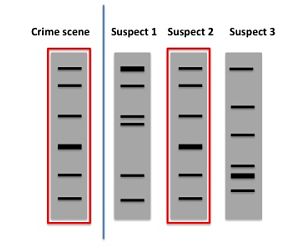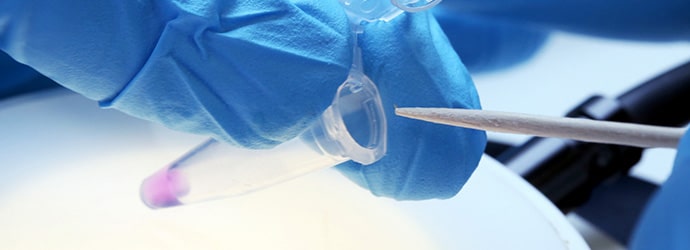Most experiments start with a piece of DNA—either plasmid DNA or genomic DNA.
To isolate plasmid DNA, you lyse your cells and perform a miniprep, trying hard to avoid contaminating genomic DNA. For genomic DNA, you crack your cells open differently to try to isolate as much of their contents as possible.
So what’s the difference in the protocols?
This article examines the main differences between plasmid vs. genomic DNA extraction and the common procedures used for both.
Genomic DNA Extraction
Lysis
Genomic DNA (gDNA) extraction is more straightforward because strong lysis is the only step necessary to release gDNA into solution. For yeast, plants, and bacteria, lysis involves enzymatically breaking the strong, rigid cell wall before mechanically disrupting the plasma membrane.
Cell walls are usually digestible with lysozyme, which hydrolyzes cell wall peptidoglycans, and the serine protease, proteinase K. For certain Gram-positive species, lysostaphin will further aid enzymatic digestion. You may need to use different enzymes for more exotic species with different cell wall compositions.
Mechanical cell wall disruption represents a more universal lysis method for gDNA extraction. Bead beating is popular, and you can easily do this on a vortex using 0.1-mm glass beads or 0.15-mm fine garnet beads. Special vortex adapters help with performing multiple extractions at the same time with equal efficiency. Bead beating is faster than enzymatic lysis and generally more thorough.
For tough filamentous fungi (e.g., Aspergillus and Fusarium spp.), cellular material is often snap-frozen in liquid nitrogen and milled in a pestle and mortar, followed by rapid vortexing in solution with an appropriate lysis buffer.
For more information on cell lysis, check out our articles that explain common lysis methods and the considerations you must make when choosing a cell lysis protocol.
Purification
Following cell lysis (which brings the gDNA into solution), the only thing left is to purify the sample. You can use phenol–chloroform extraction or spin filter membrane technology with added guanidine salts that promote binding to silica.
A Few Words of Advice
Chromosomes will break during purification because they are too large to stay intact. This is not an issue for most applications. Indeed, the breakage may be advantageous for PCR and qPCR because it aids DNA melting, resulting in more efficient amplification reactions.
However, this may be a serious issue for applications using large DNA fragments (e.g., long-read sequencing and long-range sequencing). If you need to isolate ultra-long DNA fragments for these applications, consider another setup.
The E. coli chromosome is just over 4.5 Mb in size, amounting to approximately 0.005 picograms per cell. A typical overnight culture from a single starting colony will contain approximately 1–2×109 cells/mL. Theoretically, that means that 1 mL of culture should yield about 5 µg of gDNA (assuming there are ~109 bacterial cells). Consider this when calculating how much DNA you need for your chosen application.
Plasmid DNA Extraction
Plasmid DNA extraction is a bit trickier because the plasmid DNA must be kept separate from gDNA to avoid cross-contamination. This separation is based on size, and good separation relies on using the right lysis method.
Lysis
For plasmid DNA extraction, the lysis must be much more subtle than simply chewing up the cell wall with enzymes or bashing it with glass beads. Birnboim and Doly invented the (virtually) universal method for plasmid DNA extraction via alkaline lysis in 1979.
The lysis buffer contains sodium hydroxide and SDS, which completely denature plasmid and gDNA (i.e., separate the DNA into single strands). It is critical that this step is performed quickly because excessive denaturing may result in an irreversibly denatured plasmid.
Next, the sample is neutralized in a potassium acetate solution to renature the plasmid. This is key to the separation of plasmid and gDNA. Because plasmids are small, they can easily reanneal, forming double-stranded DNA. Genomic DNA, however, is too long to reanneal fully, and instead, it tends to tangle so that complimentary strands remain separated.
During centrifugation, gDNA (bound to protein) forms a pellet while plasmid DNA remains soluble. It is key at this step not to vortex or mix the sample vigorously because gDNA breaks easily, and broken gDNA may be small enough to reanneal and go into solution with the plasmid.
Purification
Plasmid DNA in the supernatant can then be precipitated with ethanol or cleaned up using phenol–chloroform or a spin filter. If you use spin filter technology, the neutralization buffer will contain guanidine salts so the lysate can bind the silica directly for further washing and elution. The resulting DNA is pure enough for most downstream molecular biology applications. Check out our article explaining how DNA extraction kits work for more information.
If you need the plasmid for transfection, anion-exchange purification is a better choice to remove contaminating endotoxin. Endotoxin removal is also possible using faster silica-based purification setups.
This method is compatible with mammalian and other eukaryotic plasmids and other small extra-chromosomal DNA species. However, remember that plasmid copy number is often much lower in mammalian cells and plant extranuclear organelles.
A Few Words of Advice
Plasmid DNA is typically 3–5 kb, depending on the insert size. The specific origin of replication present will influence the plasmid copy number per cell. A typical high-copy plasmid such as pUC or pBluescript should yield 4–5 µg of DNA per mL of culture.
To isolate high yields of plasmid DNA, use cultures in the late log phase or early stationary phase. Prepare cultures using fresh single colonies and fresh selection antibiotics at the right concentration for plasmid maintenance. It is important not to overgrow bacterial cultures as this may result in gDNA contamination in the plasmid extract.
Plasmid vs. Genomic DNA Extraction Summarized
Hopefully, that’s cleared up the main differences between plasmid vs. genomic DNA extraction. Nowadays, there are kits for everything. And while they make life easier, it’s important to understand the basic chemistry behind their instructions.
If you enjoyed this article that (hopefully) demystifies some basic biology techniques, maybe you would enjoy our podcast, Mentors At Your Benchside. Each episode breaks down a common concept or technique in biology research, so you can become an expert on the basics, expand your practical vocabulary, and learn new soft skills. Be sure to check it out.
Originally published in 2014, republished in 2019. Revised and updated June 2023.







